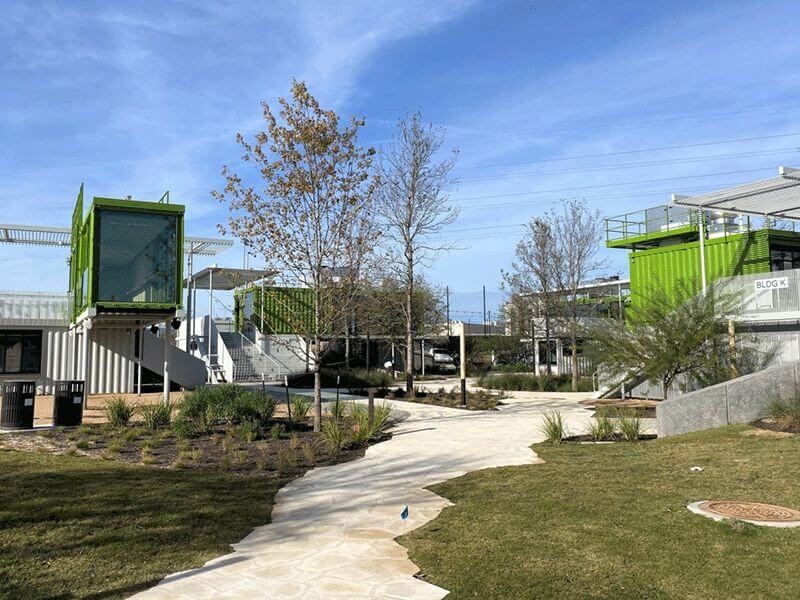Container-Based Buildings
Container-based buildings are transforming architecture, from luxury hotels to disaster relief structures. Shipping containers have become trendy for tiny home builds online over recent years, but they have the potential to do even more in the architecture industry. Here’s a look at how shipping containers transform into buildings and how they’re being used.
What are Container-Based Buildings?
Container-based buildings are structures made from recycled metal shipping containers. A typical shipping container is usually about 8.5 feet wide and 10, 20, or 40 feet long. This makes container-based buildings similar in size to a manufactured home, but made out of recycled materials. These structures can be a single shipping container, or many stacked together.
People are using container-based architecture for all kinds of buildings, from residential to commercial spaces. The shipping containers are like modular building blocks that form the main structure. Then interiors are outfitted with insulation, wall and ceiling panels, windows and doors, flooring, and electrical components as needed.
How Can Shipping Containers Be Modified?
So, how does a shipping container—designed for use carrying goods across oceans and highways—become a modern, livable building? Shipping container modification has evolved into its own architectural and interior design niche over recent years. It starts with having the right kind of shipping container.
The Best Container for Shipping Container Buildings
There are actually many unique kinds of shipping containers, such as open-side and tunnel containers. The most commonly used type for container-based buildings is the standard dry storage container. Other types of containers can be helpful in architecture, as well, though. For instance, an open-side container could be great for converting into a unit with large floor-to-ceiling windows or sliding doors on one side.
In addition to the type of container, the material also matters. The best shipping containers for architecture are made of corrugated steel. This is worth noting since steel is one of the strongest metals in the world, especially compared to weaker metals like aluminum. A steel shipping container will be able to withstand the elements and remain structurally stable enough for people to live in.
However, it is crucial to make sure the shipping container is not in poor condition. Used containers that have spent a lot of time at sea or outside in wet weather may run into issues with rust.
Learn More About Shipping Container Buildings
Case Study: The Pitch - Food and Beverage Venue in Austin, TX
The Pitch is a retail, food, and beverage venue comprised of twenty-three modified 40-foot shipping containers that sits adjacent to the Austin FC practice facility.
Shipping Container Interior Design
With the right shipping container picked out, most container-based buildings start with clean-up modifications. Black, white and blue are common colors for a fresh paint job on the exterior of the container. Before any interior changes happen, builders will usually cut holes out of the sides of the shipping container to add windows or modified doors.
Interior modifications include insulation, electrical wiring and plumbing, with wood or plastic wall panels over these components. A popular container-based building modification is smart storage systems built into the walls to maximize space efficiency.
Countertops, sinks, bathroom fixtures and cabinets are all installed along with the wall panels. Ceiling paneling and lighting are added at this stage, as well. Lighting flush with the ceiling is a common characteristic of container-based buildings. Desk space or seating areas built into the wall are also standard design elements.
Building Codes for Container Buildings
Before designing or constructing a container-based building, it’s essential to be aware of building code requirements for these structures. The International Code Council released regulations regarding shipping container buildings in 2019 and updated them in 2021.
In addition to these international building codes, many states and municipalities in the U.S. have specific local regulations for container-based structures. Anyone interested in building one should contact local or state administrator’s offices to find out about any building codes specific to their region.
Commercial, Residential, and Hybrid Container Projects
Container-based buildings are viable for all sorts of projects. While shipping container houses tend to get the most attention online, shipping containers also find use in a wide variety of commercial projects. For instance, a modern Starbucks restaurant in Taiwan is made of white shipping containers.
Shipping containers have also made gorgeous hotels and even entire sports stadiums in various spots around the world. Container-based buildings have a lot of creative potential in architecture because they function similarly to giant LEGO blocks. Designers can combine different types and sizes of containers in various configurations to get the exact layout a client needs.
Containers also make great buildings for small businesses, especially in urban areas where space is limited. Suppose a company simply needs a walled-in space to sell its goods. In that case, a shipping container is often a cost-effective way to get what it’s looking for and have the budget to customize the interior design. Healthcare businesses can even use container-based buildings for vaccine stops and express care facilities.
Possibilities for Shipping Container Buildings
Shipping container buildings are opening up new avenues in architecture that could help address urgent needs in housing and shelter. Since container-based buildings are built with recycled shipping containers, they are great candidates for affordable housing.
For example, Los Angeles constructed a large supportive housing complex using repurposed shipping containers in 2021. The project ended up being $3 million cheaper than anticipated, indicating the cost-saving potential of container-based housing. These buildings could potentially be used to relieve homelessness and housing shortages worldwide in the years ahead.
The rapid and modular-based building process for container buildings also makes them a valuable option for emergency housing where safe shelters are necessary quickly.
A Container-Based Future
Container-based buildings are highly versatile, with the potential to be sleek commercial buildings, affordable supportive housing, and everything in between. Shipping containers don’t need to go to waste — these are valuable items architects and builders can repurpose to support a thriving branch of the offsite construction industry.
2026 Events to be Announced Soon!
Join the leading companies and professionals from across the offsite construction industry at each of this year's Offsite Construction Network events. With summits and expos taking place across North America in 2026, it's never been easier to connect with and learn from offsite construction manufacturers, designers, builders, and suppliers from the United States and Canada.
Subscribe today to get the latest updates on future events from the Offsite Construction Network.

